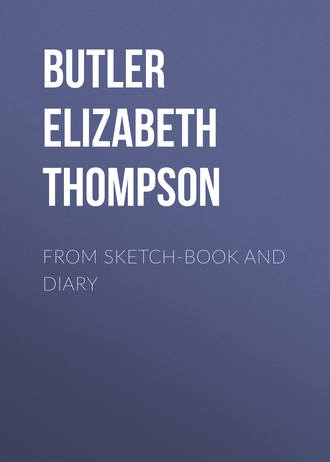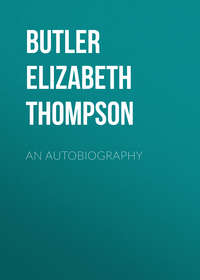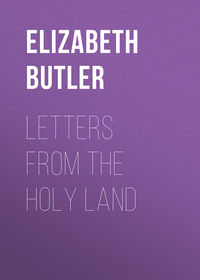 полная версия
полная версияFrom sketch-book and diary
What luck it was for us to be in Rome that wonderful year of 1870, when the Œcumenical Council filled her streets and churches with every type of episcopal ecclesiastic from the four quarters of the globe, each accompanied by his “theologian” and by secretaries in every variety of dress, from the modern American to the pig-tailed Chinaman. Great times for the art student, with all these types and colours as subjects for his pencil! The characteristics and the colour of Rome were thus multiplied and elaborated to the utmost possible point, up to the very verge of the Great Cleavage; and we saw it all.
The open-air incidents connected with the great Church functions have left an extraordinarily vivid impression on my mind on account of their eminently pictorial qualities. I see again the archaic “glass coaches” of Pope and cardinals, high-swung and seeming to bubble over with gilding, rumbling slowly up to the Church door where the ceremony is to take place, over the cobblestones, behind teams of fat black steeds, the leaders’ scarlet traces sweeping the ground. The occupants of these wonderful vehicles are glowing like rubies in their ardent robes, which flood their faces with red reflections in the searching sunshine. A prelate in exquisite lilac, mounted on a white mule with black housings, bears a jewelled cross, sparkling in the sun, before the Pope’s carriage; the postilions, coachmen, and lackeys are eighteenth-century figures come to life again, and, truth to tell, they might have brought their liveries over with them, furbished up for the occasion. Not much public money seems appropriated for new liveries in the Papal household, nor in that of the College of Cardinals. Then, the medley of modern soldiers that take part officially and unofficially in these scenes – the off-duty zouaves, with bare necks outstretched, cheering frantically, “Long live the Pope-King,” in many languages; the French Legion inclined to criticise the old liveries – it all seems to me like the happening of yesterday! And I see the rain of flowers falling on the kindly old Pope from the spectators in the balconies, where rich draperies give harmonious backgrounds to all this colour.
Times are changed at home as well as in Rome. Where are the gorgeous equipages I used to wonder at as a child on drawing-room days, that made St. James’ Street a scene of gold and colour of surpassing richness? Where are the bewigged coachmen stiff with bullion, throned on the resplendent hammercloths of their boxes? Where the six-foot footmen hanging on in bunches behind, in liveries pushed to the utmost limit of extravagant finery? We only see these things on exceptional occasions (certainly the six-footers are not grown nowadays), and the quiet landau or motor harmonises better with our modern taste.
Finally, we saw the last Papal Benediction to be given from the façade of St. Peter’s on that memorable Easter Sunday, 1870. The scene was made especially notable in its pictorial effect by the masses of bishops, all in snow-white copes and mitres, who completely filled the terrace above the colonnade on the Vatican side of the Piazza. What a symphony of white they made up there, partly in the luminous shadow of the long awning, partly in the blazing sunshine. Some of the illuminated ones used their mitres as parasols. Such a huge parterre of prelates had never been beheld before. It was a parterre of human lilies. My diary exclaims, “Oh! for Leighton’s genius to paint it. It was entirely in his style – composition, colour, and sentiment. The balustrade was hung with mellow, old, faded tapestry, and above the bishops’ heads rose those dark old stone statues that tell so well against the sky.” I remember the moment of intense silence that fell on the multitude a little before Pio Nono, wearing the Triple Crown, stood up and, in a loud voice, gave forth “to the city and to the world” the mighty words of blessing from the little balcony far up aloft. And I remember, too, how that sudden silence seemed to cause a strange uneasiness amongst the cavalry and artillery horses, which all began to neigh.
On this great day the white and yellow flag, emblem of the Temporal Power, waved upon the light spring breeze wherever one turned. How little we dreamt that in a few months that flag was to be hauled down, drawn under by the fall of the greatest military Empire then in existence!
As a postscript, do not let us forget the races of the riderless horses that took place at the end of Carnival. Those scenes are before me now, quite fresh, revived by the little old diary. I am glad I have still my sketch-books that give me the outlines of these and other scenes that are gone for ever from the world.
There is the wide round Piazza del Popolo, like an amphitheatre; the sun, near its setting, is tinging the upper portion of the great Egyptian obelisk, which is the starting-post for the occasion, with crimson, the base remaining in cool grey shade. Much stamping of hoofs and champing of bits in the ranks of the Dragoons, who are preparing to clear the Corso; French infantry forming up on either side of the starting-place; the crowds in the stands expectant, many units in carnival costume, and masked. Away go the Dragoons, splitting the crowd that blocks the entrance to the darkening, narrow Corso. They return at a gallop, having ridden to the end and back, and divide to take up their positions. Then the barbs, painted in spots and stripes, are brought on gingerly. The least jerk and it’s no use trying to form a line; they must be let go; the spiked balls, now unfastened and dangling, are beginning to prick in spite of all the care. One after the other the maddened creatures plunge and tug at the restraining grip of the convicts who act as grooms on this occasion, and who literally hold their lives in their hands, – it all passes in a quarter of a minute; down goes the rope, a gun is fired, shouts and clapping of hands ring through the chilly air, and the eleven furious horses plunge into the dark street, the squibs and tin-foil on their backs explode and crackle, the spiked balls bang against their sides. Spurts of sparks fly from their iron heels brightly in the twilight. One horse, perhaps, slips on the cobblestones, rolls over, picks himself up, and follows the others, straining every nerve. They are gone – engulfed in the dark passage, some to be recovered only after several days, wandering in the Campagna, having burst through the sheet spread to stop them at the finish.
I often wondered which ordeal a horse would prefer, if he were given the choice – this one, for a mile, or that of a great English race, with a jockey on his back with thousands of pounds to win or lose, armed with a steel whip and a pair of severe spurs! I never wholly enjoy a horse-race in any shape because of these goads in various forms.
Anyhow, I am glad these Roman races have been abolished.
I felt greatly elated when setting up work on my own account, which I did very soon after my arrival from Florence and Bellucci. He had told me at parting that I could “walk by myself” now, and I very soon walked up the steps of the Trinità to choose my first model. You remember how those costumed loafers used to sun themselves on the steps at that time? I had a half-frightened, half-delighted thrill when choosing my first Ciociaro. It was the Judgment of Paris transposed. Three of them, in peaked hats and goatskins, stood grinning and posing before the English signorina while the Papal zouave sentry and the whole lot of male and female models looked on and listened. When I gave the apple to Antonio on account of his good brown face and read waistcoat, and engaged him for the morrow, I felt I had started.
What trouble mamma and I had had in trying to find a studio. A young lady working by herself! A thing unknown – no one would let me a studio, so we ended with the makeshift you remember in our apartment. “That comes of being a woman at starting,” exclaimed mamma.
I can never pass No. 56 Via Babuino without pausing and looking up at one of the top windows where my head hung out one morning, watching my model in the street below for half an hour and wondering how long he meant to saunter up and down with his eye on the Church clock opposite instead of coming up. I had engaged him for eight o’clock for an eight-hour day (giornata finita), and there he was, strolling away a franc’s worth of sitting on purpose. “But, Signorina, one cannot always arrive to the very instant,” was the villain’s excuse on coming in. I said nothing of what I had seen out of the window. Dear old Francesco, he was much prized for his laugh, which he could keep up for twenty minutes at a time. I had already seen it in a picture in London. Of course I had a try, too, and it brought me luck, for the picture where it appears was the first Oil I sold.
Let me remind you of the Pope’s International Exhibition of Ecclesiastical Art held that winter, for which I painted “The Visitation.” The Fine Art section was shown in the Cloisters of Sa. Maria degli Angeli in the Baths of Diocletian. I laugh even now when I recall the way in which my poor picture was launched into the world. After its acceptance by the committee, I had to get a pass for its admission into the exhibition building from the Minister of Commerce, the Most Eminent and Most Reverend Cardinal B. Mamma and I had to wait an age in his ante-room, conscious of being objects of extraordinary curiosity to the crowd of men artists who were there on the same errand as myself. Evidently artists of our sex were rarities in Italy. At last our turn came to go in, and, after many formalities and much polite bowing from l’Eminentissimo and riverendissimo, I signed the several papers, and proudly followed my mamma back through the waiting artists, holding my roll of papers before me. We were informed that, being women, we could not take the picture ourselves into the Cloisters, as no order had been given to admit ladies into the monastic precincts before the opening. So our dear father sallied forth on foot with my pass to Sa. Maria, mamma and I following in a little hired Victoria, holding the big picture before us (no mean handful) to keep it from tumbling out, while hidden, ourselves, from the public eye by the carriage hood. We arrived at the entrance to the forbidden cloisters too soon, as papa had not arrived, and the gendarmes stopped us and told us to drive out of the court again. We pulled up, therefore, on the threshold, with our faces turned in the contrary direction, when the horrible hood flew back and revealed us, holding on to the picture with straining arms and knitted brows, to the grinning soldiers gathered about the place. Our dear father and Mr. Severn (Keats’ friend in youth) soon came to the rescue, and, with the aid of two facchini, they took my magnum opus and disappeared with it into the gloom of the Thermæ.
Dear, kind old Mr. Severn, he seemed so pleased to help me in my initial struggles in Rome! When I next visited Keats’ grave there, long years afterwards with W., I found another tombstone alongside of the Poet’s. There was a palette sculptured on it in place of the other one’s lyre, and one little box hedge held the two friends within its embrace. What made Oliver Wendell Holmes (if it was he) say the scent of box was the scent of Eternity? I do not know the context of the passage, but I think the idea might strike a sensitive perception in some Italian cemetery, where that most touching perfume is always on the air, and Eternity plays about our minds on the scent of the box.
From the DiaryFeb. 1906. – “And now Good-bye, Rome! I hope not a final farewell. I have been up to the Villa Medici to see across the city, on this my last evening, that dome which no one can ever look at unmoved, just at the hour which at this time of year brings the setting sun behind it, so that the crimson central ray seems to spring from the cross on the summit. Shutting out with my hand all intervening objects I seemed to see that purple dome floating in mid-air, a link between earth and heaven; a living token of the intercourse between the two, poised far above the dead ruins of the Pagan Past that lay low, in shadow, to the eastward. Good-bye.”
1
Olive Schreiner.





